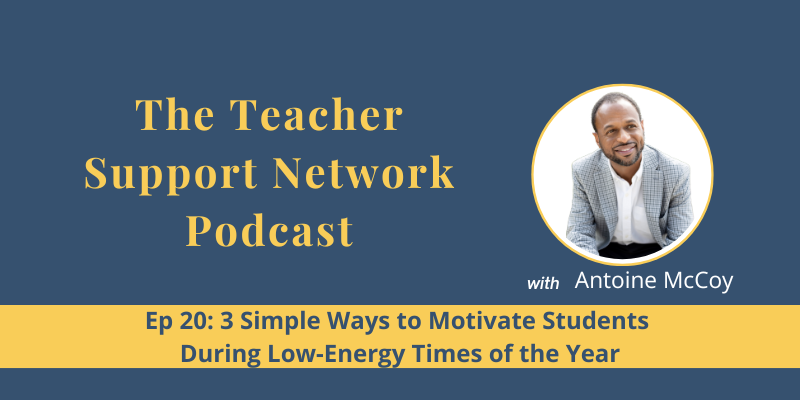
In this episode ~
Are your students zoning out, dragging their feet, or just mentally checked out? You're not alone. In this episode, we explore 3 simple student motivation strategies that work during low-energy times of the school year—whether it’s the end-of-year slump, long haul after winter break, or any week that just feels tough.
These creative teaching ideas are practical and designed to help both students and teachers get back on track.
Whether you’re facing teacher burnout or just looking for classroom energy boosters to motivate your students, you’ll leave with some ideas and tools to make your classroom feel focused, energized, and motivated—without needing a full reset.
Listen in~
00:00 Introduction and Identifying Low Energy Times
01:33 Strategy 1: Give Students More Choice
02:23 Strategy 2: Gamify the Learning Experience
04:07 Strategy 3: Switch Up the Routine
04:56 Bonus Pro Tip: Acknowledge and Own the Low Energy
05:53 Recap and Final Thoughts
Useful Resources:
Kahoot: Learning games| Make Learning Awesome https://kahoot.com
Download Gen Ed & SpEd Teachers Collaborative Conversations Guide here.
Join my Newsletter for a weekly dose of practical strategies, tips, resources and inspiration to support you on your teaching journey here.
Transcript
Hey there teachers. I'm Antoine McCoy and welcome to the Teacher Support Network podcast. Today we're tackling something every teacher faces at some point during the school year, and it's those low energy times of the year when student motivation dips, their attention wanders, and the classroom just feels kind of blah and flat.
Does this resonate with you? For many of you, you could be raising your hand. Yes. Like, yeah, that's me right now, and I hear you. So let's talk about when are these low energy times of the year?
Well, maybe it's during February to early March when the holidays are over, the weather's gloomy and spring break feels far away. Maybe it's mid-May to June, like the season we're approaching right now. When the end of the year fatigue kind of sets in and students may feel mentally checked out, especially after standardized testing. Maybe it's just been a long stretch with no break and the weather won't cooperate. Or it could be immediately after breaks when it's hard to transition back to the school and classroom routines, and students feel restless and unmotivated to re-engage.
Wherever you are in the school year when you're listening to this, if your students seem sluggish and you're feeling the same way, then this is for you. So let's dive into three simple classroom strategies that can help reignite student motivation when energy is running low.
Strategy number one, give students more choice. One of the fastest ways to re-engage students is to give them more control and agency. Choice makes students feel they have more ownership in their learning. It can be letting them pick their project format, like a poster or a slideshow, or an oral or written report, and so forth. Perhaps choosing their own topics within a unit that you're teaching to go deeper in a little.
Independence and autonomy can go a long way. You might offer a menu of assignment options or let students vote on a class activity. When students feel like they have a say in what's going on in the classroom, their effort in the class often increases naturally. So strategy number one is to give students more choice.
Let's move on to strategy number two. I call it gamify the learning experience. So when the room energy is low and students feel tired, then it's time to play y'all! Gamifying learning doesn't have to be complicated. Think about how you could take your math, reading, writing, or any other content area that you teach and present it in a form of a fun game or activity.
Here are some ideas to consider and you can see whether or not it will fit with your content area or with the age of your students. So you can use a set of dice or deck of cards to help boost math instruction in a fun way.
Board games and puzzles are great ways to build reading skills, higher order, and abstract thinking skills. It can also help promote social-emotional learning and improve group dynamics as well.
This one is one of my favorites: Integrate interactive technology with your content specific subjects using Kahoot.
Ever heard of Kahoot? Well, if you haven't, you need to learn about Kahoot. Kahoot is a game-based platform that can make learning fun through games. You can review your content on kahoot, and you can even do quizzes using the platform. Students really perk up when there's competition or a goal beyond, “ Let's just finish the worksheet.”
So think about these different ways to help gamify the learning experience for your students during these low energy slumps of the year. It is amazing how a little fun can jump start focus even in those weeks that drag.
Now let's talk about strategy number three. Switch up the routine. Routines are great for structure, but during a slump, having novelty and something new in your back pocket can really be your secret weapon.
Try rearranging your classroom layout, maybe doing a lesson outside if the weather permits. Have students swap seats for a day. Maybe introduce a mystery box challenge that you're gonna try to figure out together as a class. Add music during work time, if it's something that you don't normally do.
Even just changing how you deliver a lesson, like using stations or partner work, when you usually do whole group instruction, can really reset the classroom energy. Small changes create curiosity and curiosity drives attention up.
So I'm gonna end with a bonus pro tip: Acknowledge the low energy and as a class community, own it together.
This one might be the most powerful strategy because you name the energy dip and then you make a plan with your students to push through it together. Let them know how you feel about it too, and then ask them what helps them stay focused? “What can we do as a class to finish strong?”
Invite their input. Let them help create a motivational strategy with you. You'll be amazed at how much buy-in this can really build with your class. When students feel like they're part of the solution and not just the problem. You've foster a real sense of shared inclusion, ownership, and collaboration with all members of the class.
So let's recap these three simple motivational boosters discussed in this episode. So the first one was to give students more choice. The second was to gamify your content and the learning experience. The third was to shake up the daily routine to invite curiosity. And I added a bonus pro tip, which was to acknowledge the slump and the dip in motivation, and then co-own the comeback together as a class.
Remember, you don't need to overhaul your whole class to make a difference. Just pick one of these strategies to try this week if you're in that low season, and see what happens. Small shifts can really bring big energy back to your students and to be honest and to you as well.
So this episode was helpful, please share it with a teacher friend and please visit the show notes page for other resources and this episode's transcript. If you have time, drop a quick review on Apple Podcast, Spotify, or whatever platform you are listening to this episode on because it really helps more educators like yourself find a show.
Okay, that's it for this episode. Thanks for tuning in this week. Bye now.
Rate, Review, & Subscribe on Apple Podcasts
Enjoy this episode?
Please consider rating and reviewing the podcast! Your support helps me support more teachers - just like you - create inclusive classrooms, foster effective teacher collaboration, and find balance with the demands of teaching in and outside of the classroom
It's easy! Click here, scroll to the bottom, tap to rate with five stars, and select "Write a Review." I'd love to know what was the most helpful or encouraging about the episode!
While you're there, you can subscribe to the podcast if you haven't already. If you're not subscribed, you may very well miss out on future episodes. 🙂 Subscribe now!


